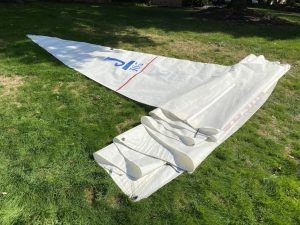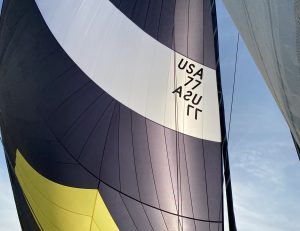When you head offshore in your boat, you’ve got to take everything with you. You need sails for a variety of conditions; you need some backups and spares, and you’ve got finite room to store it. So what are some good choices for your sail locker when you cross an ocean or head off on a multi-day passage?
It’s not a simple answer, since it depends on your boat, the duration of your trip, why you’re sailing, who’s going with you, where and when you’re going, how long you’ll be there. If you’re leaving home for a three-year world cruise, you’ll think differently from someone prepping for the Newport-Bermuda race or a summer-long cruise from Annapolis to Newfoundland and back.
This article will focus more on shorthanded requirements for cruising; racing is another whole discussion because your sail choices are more tactical and varied and you have more people to get them done. Most cruising boats have two to four adult crew, and they don’t make so many sail changes and the responses to changing conditions are very different.
Mainsails
 A sturdy and reliable mainsail is the backbone of your offshore sailing inventory. It should be able to keep its shape for upwind trim; even if you do your best to avoid beating, there will be times you can’t avoid it on a long ocean trip.
A sturdy and reliable mainsail is the backbone of your offshore sailing inventory. It should be able to keep its shape for upwind trim; even if you do your best to avoid beating, there will be times you can’t avoid it on a long ocean trip.
Every offshore mainsail needs reef points unless it’s on a main furler. Many cruising sails come with two, but a third reef point gives you more options. You want to get that sail down to a tiny triangle without completely dousing it. A little sail area can keep you under control and help you heave-to in terrible conditions without breaking out the storm sails.
Furling mainsails are convenient for cruising, but there is a lot of debate about in-mast versus in-boom furling. Both types of furling can fail, though with in-boom furling you can usually get the sail down. The other major difference is the sail shape. In-mast furling sails can only have vertical battens, but a boom furled main can have full battens. Boom furled sails generally have better shapes and can have a roach.
Other features to look for on your cruising main include chafe patches where the sail may touch the rig going downwind, and extra UV protection where the sail is exposed when stowed, like the clew of main furling sails.
If you have the space to stow it, an old mainsail for a backup is a good idea. On an ideal cruise, nothing terrible will happen to your nice main. But if it does, you’ll be happy to have any mainsail to get to your next port, even if it’s stretched out and tough to trim.
Headsails
You won’t swap out headsails often on a cruising passage. Most cruising boats today have furlers, so you’ll just furl a big headsail in to reef it instead of changing sails. But a couple of different headsails to choose from before you set out on passage will give you more options and better sailing.
A versatile Genoa for most moderate conditions will be your go-to sail for most of your passage making. You don’t want a giant light air deck-sweeping sail. This is a sail with about a 130% overlap to give you traction in light air reaching, but not overpower you when the wind gets closer to twenty.
Make sure furling headsails will reef well with luff foam to help keep the sail shape. You may need to reduce sail a lot in the middle of the night, and reefing from the cockpit is a lot nicer than running forward swap out a sail.
Besides an oversized headsail for lighter and easier passages, a 100% working jib is a versatile tool if you’re expecting a trip with more upwind sailing or heavier conditions. Upwind in higher apparent winds, that smaller sail will still give you excellent point with better shape than a furled Genoa. It will also keep you more comfortable by reducing heel and weather helm, so your upwind passage is easier.
The other reason to carry the working jib is for a backup sail. Just like the main, if something happens to the primary sail, you’ll be happy to have another headsail in your inventory.
If you have a cutter rig or a second, optional inner forestay on your sloop, you’ll want to get a staysail for that extra sail area and cross-the-wind performance.
Downwind Sails
Cruising offshore isn’t a great place for symmetrical spinnakers. For most, they’re too complicated to set up and manage short handed, and concentrating to keep them trimmed while you sail is exhausting for hours on end. Instead, most cruising sailors look to asymmetrical cruising spinnakers and gennakers or furling code sails for off-the-wind sailing.
An asymmetrical spinnaker (or gennaker) is an excellent option for downwind sailing on broad reaches. When the wind drops, these can be the difference between sailing and motoring. Look for a sail with some setting and dousing help, like a turtle and sock, to help your crew manage the sail singlehanded. New top-down furling systems are even easier to set and douse.
The other light air sail to consider is a furling code zero. A “code sail” has a shape more like a triangular headsail, but is made from a lighter cloth and cut for reaching and close reaching. It’s free flying like a spinnaker instead of connected to the headstay, and furlers made from high modulus lines make these sails easy to set and take down.
Storm Sails
All offshore sailors should have storm sails. These sails are small and made from very heavy sailcloth and finished with high visibility cloth for visibility in awful conditions.
A storm trysail usually runs up a special track on your mast; if you don’t have a storm trysail track, you will need to add one. It trims a different sheet than your regular main, so you can hoist it on a spare halyard or even the topping lift (if it’s adequate) and you won’t need to remove the mainsail. We used old main halyards for our topping lifts for this reason.
The storm jib replaces the headsail with a tiny sail that still has enough shape to help with heaving to or sailing forward. Originally, storm jibs were hank-on sail that replaced the jib after dousing. Roller furling made this less practical – the whole idea of storm sails is they’re quick to rig when things get nasty, so you won’t hesitate to get them out. Pulling off a furling genoa in a gale isn’t something you want to do.
Several options for storm jibs which work over the furled headsail are available, and cutters and boats with inner forestays can fly a more traditional storm jib.
An important note about storm sails – take them out and practice with them. They rig differently than your normal cruising sails, and you may need additional lines or hardware to get them flying. It’s better to learn this dockside near a sailmaker than a few hundred miles offshore in a building blow.


